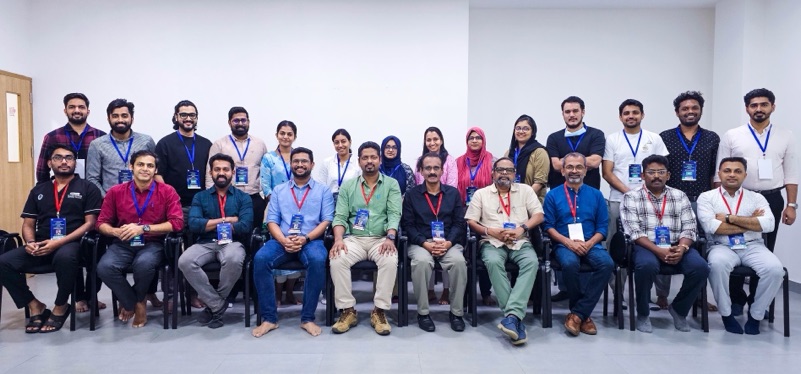Pain is the Concern of the Sufferer
An Experience That Changed My Perspective on Pain
By Dr. Venugopalan P. P.
A January Morning Full of Promise
It was a beautiful January morning in 2017. I was in Coimbatore to attend the National Conference on Indian Paramedics, organized by the EMS division of SEMI—Society for Emergency Medicine in India—at KG Hospital. The venue was electric, filled with over 500 paramedics from across the country.
The inauguration began at 11 a.m., with Padma Shri Awardee Dr. Bakthavatchalam delivering a soul-stirring keynote. SEMI leaders graced the dais, and I was scheduled to speak shortly after. My session focused on the importance of community-based EMS in India and the powerful role that Public-Private Partnerships (PPP) can play. I shared the impactful story of ANGELS (Active Network Group of Emergency Life Savers)—a model that has saved countless lives.
.png) |
| EMT Paramedic Conference at KG Hospital Coimbatore 2017 |
After lunch, I returned to my hotel room for a short break. But the vibrant streets of Gandhipuram, with their famous shopping spots—Kumaran Silks, Pothys—beckoned. I stepped out to pick up a few gifts for Supriya and Neethu.
A Sudden Turn of Events
By 3:30 p.m., my shopping was done. I began the walk back. As I reached the Pothys junction, I joined a group of pedestrians crossing the road. I was the last in the crowd. Despite a red signal, vehicles zipped by in all directions—a typical Indian traffic story.
 |
| Gandhipuram |
Just as I was stepping off the road, something—likely a bike—slammed into my right leg. I crashed to the ground. My shopping bag flew out of my hand. I looked down—my leg was deformed. The pain was instant and unbearable. Yet, there was no bleeding. Someone handed me the bike’s registration number. I slipped it into my pocket, still dazed.
Strangers rushed to help. A few kind souls hailed an auto-rickshaw. One young gentleman rode with me—I never knew his name. I just rested on his shoulder, overwhelmed. He was my first guardian angel that day.
 |
| My guardian angel with Dr. Fabith and Dr. Narendra Jena |
The Pain That Was Overlooked
By 4:00 p.m., I was in the casualty of a well-known orthopedic hospital. I was put on a stretcher. The pain in my ankle was now searing—every movement was excruciating. Someone inserted an IV line. I waited, hoping for pain relief. It never came.
No one assessed my pain score. No one asked me about my pain. As a physician who teaches acute pain management, this was disheartening. By 4:45 p.m., an X-ray confirmed a bimalleolar fracture. A nurse approached with an intramuscular injection and asked me to expose my gluteal region.
I asked, “What is this for?”
“Painkiller,” he replied.
I said, “But I already have an IV line. Why not give IV analgesia? My pain score is 9/10.”
His answer was simple: “The doctor ordered this.”
I never even saw that doctor.
I refused the injection. Later, I learned the ED didn’t have access to IV opioids. They simply lacked the infrastructure or protocol to manage pain adequately.
Meeting the Godman in Scrubs
By then, my SEMI colleagues—Dr. Fabith, Dr. Jena, Dr Sai Surendar, Dr. Srinath, and Dr. Saravana—had arrived and expedited my care. Around 6:00 p.m., I was taken to the pre-operative room.
My pain was now 10/10.
And that’s when I met the real God.
A man appeared beside me in OT attire. Calm, composed. He gently touched my hand and felt my pulse. His presence was reassuring.
He lowered his mask and said, “I am Dr. Bala Venket, Anaesthesiologist.”
 |
| Dr.Bala Venket https://aosrapm.org/pdf/Dr-J-Balavenkatasubramanian.pdf https://drbalavenkat.org/ |
His voice was soft, his demeanor divine.
He took a quick history and told me, “Don’t worry. You’ll feel comfortable soon.”
He gave me an IV opioid. Within minutes, my pain dropped to 4/10. Then he said he’d perform a popliteal nerve block using ultrasound. I panicked, worried they’d move me or turn me prone, worsening the pain. But Dr. Bala gently assured me:
“You’ll stay in the same position. I might tilt you slightly. You won’t feel more pain.”
Within five minutes, the block was done. My pain score dropped to zero. Absolute stillness. A cold hand touched mine again, and I felt a sense of peace that’s hard to describe.
 |
| USG-guided Popliteal Nerve block |
I was then wheeled into the OT, where the orthopedic team performed a closed reduction and applied a slab. I decided to have the surgery done later in Calicut, closer to home. Interestingly, I don’t even recall the orthopedic surgeon’s name. But I remember Dr. Bala Venket vividly—because he relieved my pain and touched my soul.
The Takeaway
Pain is the concern of the sufferer. But too often, we, the treating physicians, overlook it.
That day, I was a patient—and I felt the neglect firsthand. Despite all our advancements, adequate pain management is still missing in many Indian emergency departments. It is not about luxury. It is about dignity.
The Montreal Declaration, adopted at the International Pain Summit in 2010, proclaims that access to pain relief is a fundamental human right.
Emergency Physicians must:
-
Assess pain scores.
-
Be trained in the use of opioids and nerve blocks.
-
Never hesitate to treat pain adequately.
-
Speak to patients with compassion and humanity.
A well-done nerve block is not a fancy skill. It can change a patient’s entire experience. And a kind touch, a warm smile, a few comforting words—these are sometimes the best medicine.
Gratitude
I met Dr. Bala again at a function in Delhi in 2023 and personally expressed my heartfelt gratitude. He is not just an anesthesiologist—he is a healer in the truest sense of the word.
 |
| Dr Bala Venket, The man with a Magical touch https://www.gangahospital.com/awards_doc_nat_oration/29 |
This story does not end here. It continues—with resilience, recovery, and reflections.
Part 2: Recovery and Resilience – Coming Soon





